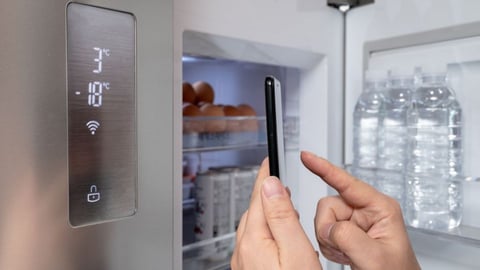Q&A: Henkel's Dean General on Prioritizing IT Innovation Investments and a Digitally-Powered Supply Chain
Henkel has made significant progress toward developing a digitally-powered, streamlined and centralized enterprise over the last year. What prompted the massive shift to IT priorities? Last year, the company initiated the merger of its laundry, home care, and beauty divisions to create Henkel Consumer Brands — a massive undertaking that kicked off the business’ recent burst of tech innovation.
Since then, the company has invested in its IT infrastructure, expanded automation and tech capabilities within logistics, and taken steps toward reorganizing its digital and IT teams to support ongoing initiatives.
CGT connected with Dean General, SVP of commercial development, sales and GM retailer brands for Henkel Consumer Brands North America, to learn more about the company’s digital transformation investments across the supply chain — despite ongoing economic headwinds — and how these changes will trickle down to the end-consumer.
A Deeper Look Into Henkel
The Henkel merger is the latest step in the company's strategy to build a single multi-category platform that combines its consumer brands and businesses. Read more.
As part of the merger, Henkel is taking a closer look at its IT structure. Read more.
Henkel has implemented a new workforce solution aimed at streamlining internal IT support services for their global network of remote employees. Read more.
Henkel was recognized as a Most Sustainable company in 2022. Read more.
What opportunities is the company looking to tap into with the merger of Henkel's laundry, home care, and beauty divisions?
Last year we announced the merger of our laundry and home care and beauty care business units to form the new Henkel Consumer Brands, a new business unit organized around customer and channel centricity. This merger was part of our strategy to build a multi-category platform for growth and improve the simplicity of our interaction and collaboration with our customers.
With this merger, we are focusing on creating a more customer and category focused organization. These efforts enable a simpler organization more focused on joint value creation with our customer base. These structural moves also allow us to capture significant synergies internally, helping us manage a very dynamic inflationary environment with our retail partners.
By streamlining areas such as distribution and supply chain, we are also aiming to advance the entire consumer business with leaner structures and faster decision-making, offer bigger roles and opportunities to our employees, and become an employer of choice.
How are new digital solutions helping to streamline and optimize efficiencies, particularly across the supply chain?
We see digital transformation as a journey, not a destination. It’s about finding new ways to use data and the latest technologies to bring more value to the business and especially our employees, customers, and consumers. Digital transformation positions us to be prepared for the future by changing the way we operate and meet emerging demands.
We have several efforts underway in North America that are contributing to this journey. Henkel DX is the Digital Business Unit at Henkel which was founded in 2020 and has been the driving force of Henkel’s digital transformation. Together, we develop new digital solutions and business models, while keeping our customers’ needs as our main focus.
We’ve recently made significant strides to help streamline and optimize efficiencies through several plant expansions and system integrations. These updates have enabled us to take our operations to another level and respond quicker to industry and macroeconomic trends.
One project I’m particularly excited about was the expansion we completed last year at our facility in Bowling Green, Kentucky to make it our most technologically advanced logistics operations. The $70 million upgrade supports Henkel Consumer Brands and integrates Industry 4.0 innovations to help optimize storage space, enhance efficiency, and drive digital automation. With this expansion, we were able to increase our capability to store pallets from 88,000 to 200,000 pallets and increase trucks’ throughput from 200 to 1,000.
As we look toward the future, we are continuously looking for ways to integrate advanced technologies like artificial intelligence and blockchain into our everyday processes. These technologies are key to revolutionizing our business. Artificial intelligence is helping make our lives more convenient and blockchain is promoting transparency by simplifying daily interactions.
As we navigate a period of economic uncertainty, how is Henkel balancing digital transformation with financial stability?
It can be difficult to continue looking ahead during times of uncertainty, but at Henkel, every decision we make is guided by our values and commitments. Our purpose is built from our roots and carries a long-standing legacy of innovation, responsibility, and sustainability into the future — so even during tough times, our priority is to those values.
Digitalization is a major part of our strategic framework for purposeful growth and the key to the future of Henkel, so we’re continuing to have a strong digital business focus which we believe is also key to navigating economic headwinds. With our newly formed Henkel Consumer Brands, digital automation capabilities and data and insights, we can respond quicker to these issues and maintain stability.
Macroeconomic trends such as labor constraints and supply shortages are still going to impact companies, and for Henkel, we are embracing this evolving climate proactively — with our customers and consumers at the center of all we do.
How is this being juggled with rapidly shifting consumer needs?
Digitization makes us more agile and responsive, so that as consumer needs and demands change, we can adapt. In our laundry category, our data revealed some pull back from consumers and changes in their needs and buying habits. We saw a shift in their needs within fabric care and protection, as well as an increase in consumers turning to larger sizes, value propositions, and in some cases even trading to retailer brands.
We are using these types of insights to ultimately serve our consumers and our customers with our family of Henkel consumer brands.
What other innovation investments are on the horizon?
Henkel is pursuing an agenda of purposeful growth and has developed a clear strategic framework that includes building a successful portfolio; clear competitive edge in the areas of innovation, sustainability, and digitalization; as well as future-ready operating models based on a strong company culture. We are using data and insights on what drives our consumers to look at new ways to reach them and remain agile.
I’m looking forward to seeing what new innovations come from our technical application center we opened in Santa Clara, California last year. The investment helped enhance our collaboration with our consumer electronics customers. We invested about $2 million into dispensing robots, 3D printers, and other assets for the center, which helps expedite proof-of-concept initiatives for electronic advances, and provide immediate prototype design and analysis support.






